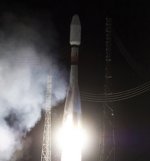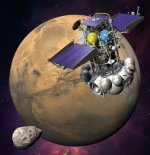Soyuz rocket falls in Siberia after launch mishap
Dec 23 - A Russian communications satellite failed to reach orbit Friday after the failure of the upper stage of its Soyuz rocket, the latest in a string of Russian launch failures. The Soyuz 2-1b rocket lifted off from the Plesetsk Cosmodrome in northern Russia at 7:08 am EST (1208 GMT, 4:08 pm Moscow time) carrying a Meridian communications satellite. While the launch initially appeared to go well, Russian officials later said the satellite failed to reach orbit and instead crashed in Siberia. Initial reports indicated a problem with the rocket's third stage. The launch failure is the fifth in just over a year for Russia, including the loss of a Progress cargo spacecraft on another Soyuz rocket in August. In addition, Russia's Phobos-Grunt Mars spacecraft was successfully launched in November, but was stranded in Earth orbit because of an unknown problem with the spacecraft.
FULL STORY
Final Chinese launch tally surpasses U.S. rocket fleet
For the first time since the dawn of the space age, China's Long March rocket family eclipsed the annual flight rate of the U.S. fleet of space launchers Thursday with the successful deployment of a high-resolution mapping satellite.
FULL STORY
Cosmic Fail! Biggest Space Flops of 2011
Rockets have been launching people, robots and satellites into space for more than 50 years. But major failures still occur, highlighting just how hard it is to escape the bonds of Earth on a rocketship bound for orbit. The year 2011 saw its share of launch and mission failures; thankfully, none of them involved astronauts. Here's a recap of the biggest space disappointments of the year:
More...Astronomers announced Tuesday the discovery of the first planets similar in size to the Earth around a Sun-like star. The planets, designated Kepler-20e and Kepler-20f, orbit a Sun-like star 1,000 light-years away. Kepler-20e has a radius of 0.87 Earth radii, making it slightly smaller than Venus, while Kepler-20f is slightly larger, at 1.03 Earth radii. The two planets closely orbit their star, with orbital periods of 6.1 and 19.6 days, putting them well inside the star's habitable zone. Scientists hailed the discovery, though, as the first time a planet as small as the Earth has been found around a star similar to the Sun. The discovery was made using data collected by NASA's Kepler spacecraft as it observed transits of the planets across the star. Three other planets, larger than Earth but smaller than Neptune, have aslo been detected in Kepler observations of the star.
Related Links: NASA press release ;
SPACE.com article ;
China launches communications satellite for Nigeria
Dec 20, 2011 - A Chinese rocket placed into orbit Tuesday a new communications satellite for Nigeria. The Long March 3B lifted off from the Xichang Satellite Launch Center at 11:41 am EST monday (1641 GMT Monday, 12:41 am Beijing time Tuesday) and placed the Nigcomsat-1R satelite into geosynchronous transfer orbit. The satellite, built by China Academy of Space Technology, will replace an existing Chinese-built communications satellite for Nigeria that failed in orbit in 2008. The 5,100-kilogram satellite will operate at 42.5 degrees east in GEO, providing communications services in several frequency bands for Nigeria.
Still more than two months until next Ariane 5 launch
Arianespace is readying the first Ariane 5 for launch in 2012 from French Guiana following delivery of this heavy-lift workhorse by its industrial prime contractor, Astrium.
The Ariane 5 ES vehicle is now in the Spaceport's Final Assembly Building following its transfer from the Launcher Integration Building - where it underwent integration of its core cryogenic stage, solid propellant boosters, equipment bay and EPS upper stage.
This version of Arianespace's workhorse heavy-lift launcher is now ready to receive its payload: the third Automated Transfer Vehicle (ATV) cargo resupply vessel developed by Europe for servicing of the International Space Station.
The latest ATV is named after Italian physicist Edoardo Amaldi and will carry an estimated 6,960 kg of dry cargo, propellant, water and gas when it lifts off on 9 March 2011 from French Guiana.
Arianespace is entrusted with the orbiting of ATVs under contract to the European Space Agency. The company lofted the first ATV (named after Jules Verne) in March 2008, which was followed by the launch of ATV Johannes Kepler in February 2011.
The ATV launch will mark the end of an almost half-year long hiatus in Ariane 5 launches. The last Ariane 5 launch was that of Arabsat 5C and SES 2 on 21 September 2011. Moreover, details regarding the next commercial Ariane 5 launch have not been announced yet. It is not expected to occur before April 2012, though. According to earlier reports, Arianespace is facing growing problems finding matching satellite pairs to fit with their dual launch strategy.
Source: Arianespace PR
NASA, Industry discuss new booster development for Space Launch System
On 15 December, more than 120 aerospace industry leaders from more than 70 companies attended the Space Launch System's Advanced Booster Industry Day held at Marshall Space Flight Center in Huntsville, Alabama. The event focused on a NASA Research Announcement for the Space Launch System's (SLS) advanced booster.
Marshall is leading the design and development of the SLS on behalf of the agency. The new heavy-lift launch vehicle will expand human presence beyond low-Earth orbit and enable new missions of exploration across the solar system.
For explorations beyond the first two test flights, the SLS vehicle will require an advanced booster with a significant increase in thrust over existing U.S. liquid or solid boosters.
Through this research announcement, NASA is seeking proposals for engineering demonstrations and/or risk reduction strategies for advanced booster concepts. The aim is to reducing risks while enhancing affordability, improving reliability and meeting our performance goals during an initial 30-month phase prior to the full and open Design Development Test and Evaluation (DDTE) competition. The total award value for the research announcement is US$200 million with multiple awards anticipated.
NASA anticipates initiating a full and open competition for the advanced booster system in FY2015 with award anticipated in FY2016 and hardware delivery in the FY2019 timeframe. The 130-metric-ton, evolved SLS is slated for completion following the 2021 test flight.
Reference: NASA PR













